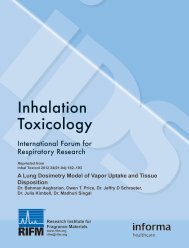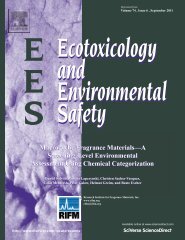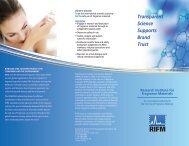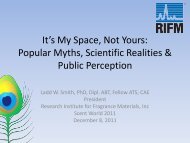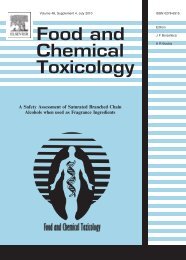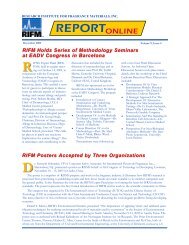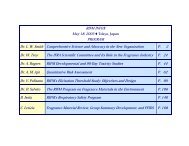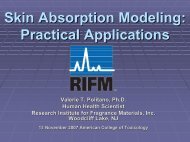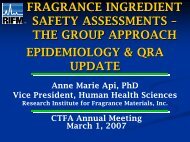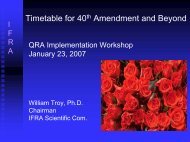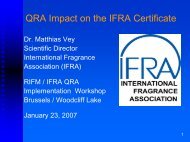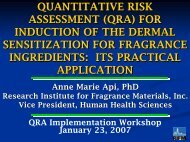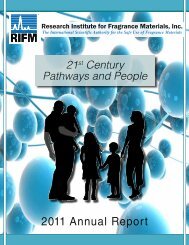Fragrance Ingredient Safety Assessments - Research Institute for ...
Fragrance Ingredient Safety Assessments - Research Institute for ...
Fragrance Ingredient Safety Assessments - Research Institute for ...
You also want an ePaper? Increase the reach of your titles
YUMPU automatically turns print PDFs into web optimized ePapers that Google loves.
FRAGRANCE INGREDIENT<br />
<br />
SAFETY ASSESSMENTS –<br />
THE GROUP APPROACH<br />
EPIDEMIOLOGY & QRA<br />
UPDATE<br />
Anne Marie Api, PhD<br />
Vice President, Human Health Sciences<br />
<strong>Research</strong> <strong>Institute</strong> <strong>for</strong> <strong>Fragrance</strong> Materials, Inc.<br />
CTFA Annual Meeting<br />
March 1, 2007
RIFM SCIENTIFIC PROGRAM<br />
<br />
RESEARCH & TESTING<br />
DATABASE<br />
PUBLICATIONS<br />
Respiratory <strong>Safety</strong> Program<br />
<strong>Fragrance</strong> Allergy<br />
Human Health Methodology<br />
• Epidemiology Study<br />
• Elicitation Threshold<br />
• Oxidation <strong>Research</strong><br />
• Quantitative Risk Assessment<br />
In vitro Sensitization<br />
Environmental Methodology<br />
Group Health/<br />
Environmental Testing<br />
Use Level Testing<br />
High priority materials (proactive<br />
program) – fill data gaps <strong>for</strong><br />
multiple endpoints to allow<br />
completion of group summaries<br />
Support of IFRA Standards<br />
CTFA Mar 2007 AM Api
FOUR IMPORTANT<br />
<br />
PUBLICATIONS<br />
• Human Health Criteria Document<br />
Reg. Tox. & Pharm., 31, 166-181, 2000<br />
• Environmental Framework Document<br />
Env. Tox. & Chemistry, 21, 1301-1308, 2002<br />
• RIFM Expert Panel <strong>Safety</strong> Evaluation<br />
Process – Reg. Tox. & Pharm., 37 (2), 218-<br />
273, 2003<br />
• Industry Exposure Consideration<br />
Practices - Reg. Tox. & Pharm., 36, 246-<br />
252, 2002<br />
CTFA Mar 2007 AM Api
GROUP APPROACH<br />
• Used by many groups <strong>for</strong> quite some<br />
time<br />
OECD process<br />
US EPA<br />
Joint FAO/WHO Expert Committee on Food<br />
Additives (JECFA)<br />
FEMA Expert Panel (flavors)<br />
RIFM Expert Panel (fragrances)<br />
• Successful example in the OECD<br />
process<br />
Solvents propyl acetate and butyl acetate<br />
Both are easily metabolized by esterases<br />
to the corresponding acid and alcohol,<br />
which are the ultimate active molecules.<br />
CTFA Mar 2007 AM Api
GROUP APPROACH<br />
• Chemical structure helps to predict<br />
transdermal absorption<br />
metabolism<br />
disposition<br />
functional groups that can influence<br />
toxicity<br />
• Group safety evaluations can<br />
demonstrate that within a congeneric<br />
group similar biochemical fate and<br />
toxicological potential can be exhibited<br />
• It can be shown that the group is<br />
efficiently detoxicated to yield the same<br />
or similar metabolites.<br />
CTFA Mar 2007 AM Api
RIFM GROUP APPROACH<br />
<br />
• 88% are structurally simple,<br />
Low molecular weight<br />
Predominantly semi-volatile substances<br />
Consisting of carbon, hydrogen and oxygen<br />
• Majority can be assigned to several<br />
homologous groups of structurally<br />
related materials<br />
~ 2,100 chemically defined fragrance<br />
ingredients<br />
22 Groups (e.g. Acids, Acetals, Alcohols)<br />
> 150 Subgroups (e.g. Straight chain<br />
saturated, straight chain unsaturated etc.)<br />
CTFA Mar 2007 AM Api
RIFM GROUPINGS FOR<br />
FRAGRANCE INGREDIENTS<br />
<br />
Ketones<br />
10%<br />
Volume of<br />
Hydrocarbons<br />
4%<br />
Musks<br />
6%<br />
Aldehydes<br />
15%<br />
Use<br />
Other<br />
8%<br />
Alcohols<br />
23%<br />
Esters<br />
34%<br />
Number of<br />
Materials<br />
Esters<br />
33%<br />
Hydrocarbons<br />
4%<br />
Alcohols<br />
16%<br />
Aldehydes<br />
10%<br />
Musks<br />
0.3%<br />
Other<br />
26%<br />
Ketones<br />
12%<br />
CTFA Mar 2007 AM Api
RIFM GROUP APPROACH<br />
• Basis majority of safety evaluations<br />
Can reasonably predict some degree of<br />
consistency of metabolism and toxicity<br />
For most, it can be shown that the group is<br />
efficiently detoxicated to yield the innocuous<br />
metabolites<br />
Low systemic exposure levels (many below<br />
thresholds of toxicological concern)<br />
• Existing in<strong>for</strong>mation <strong>for</strong> a group<br />
may need to submit a fragrance ingredient<br />
to full toxicological testing OR<br />
it may be necessary to test one or more<br />
particular members of a group to obtain<br />
more robust data to solidify assessment of<br />
the class as a whole<br />
CTFA Mar 2007 AM Api
CRITERIA DOCUMENT DIRECTS<br />
TEST PROGRAM & GROUP SELECTION<br />
• High priority - linalool and linalyl acetate<br />
• Linalool & Related Ester Group<br />
Linalool<br />
Linalyl acetate<br />
Linalyl benzoate<br />
Linalyl butyrate<br />
Linalyl cinnamate<br />
Linalyl <strong>for</strong>mate<br />
Linalyl hexanoate<br />
Linalyl isobutyrate<br />
Linalyl isovalerate<br />
Linalyl phenylacetate<br />
Linalyl propionate<br />
• Evaluation of linalool will support linalyl<br />
ester group (11) AND non-cyclic terpene<br />
alcohol group (46)<br />
CTFA Mar 2007 AM Api
GROUP SUMMARY IMPACT<br />
<br />
• For the first time, REXPAN makes a<br />
conclusion in a peer-reviewed, scientific<br />
publication<br />
• Exposure data (from IFRA) is included.<br />
<br />
<br />
Use Levels (dermal & systemic)<br />
Worldwide Volume of Use (in ranges)<br />
• Expeditious<br />
• Greatly reducing animal testing<br />
• Cost Saving<br />
Low volume materials will NOT need the<br />
same amount of test data.<br />
CTFA Mar 2007 AM Api
SAFETY EVALUATION<br />
<br />
PUBLICATIONS<br />
GROUP SUMMARY<br />
Author: REXPAN<br />
<strong>Safety</strong><br />
Evaluation<br />
Monographs<br />
FMR<br />
Author:<br />
RIFM<br />
STAFF<br />
FMR<br />
Author:<br />
RIFM<br />
STAFF<br />
FMR<br />
Author:<br />
RIFM<br />
STAFF<br />
Material<br />
Details<br />
CTFA Mar 2007 AM Api
GROUP SUMMARIES (FMRs)<br />
<br />
‘98 ‘99 ‘00 ‘01 ‘02 ‘03 ‘04 ‘05 ‘06 ‘07 ‘08 ‘09 ‘10<br />
Linalool (11)<br />
Cinn. Alc., Acid, Ald. (3)<br />
Ionones (35)<br />
3 Sub. Cinn. Grps (55)<br />
Salicylates (18)<br />
Non-Cyclic Terpene<br />
Alcohols (46)<br />
Cyclic Terpene Alcohols<br />
(33)<br />
Esters Acetates Cyclic (30) ?<br />
Aryl Alkyl Alcohol (40)<br />
Aryl Aldehydes (20)<br />
Alcohols Branched<br />
Chain (56)<br />
Aryl Alkyl Aldehydes Cinn.<br />
& Propionald. (21)<br />
Esters Acetates<br />
Terpenes Cyclic (31)<br />
Ketone Cyclopentanones (26)<br />
Esters Acetates Aryl Alkyl (22)
GROUP SUMMARIES (FMRs)<br />
• 2003 Linalool and Related Esters (11)<br />
• 2005 Cinnamic Ald., Acid, Alc. (3)<br />
• 2006 (90)<br />
Ionones (36)<br />
Salicylates (18)<br />
Substituted Cinnamyl esters (25)<br />
• Total 2006: 5 groups; 104 FMRs<br />
• Goal 2007 (109)<br />
Cyclic & Non-cyclic Terpene Alcohols (65)<br />
Substituted Cinnamyl Aldehydes (33)<br />
Substituted Cinnamyl Phenyl Propyl (11)<br />
• Goal 2016: 56 groups; >1300 FMRs<br />
CTFA Mar 2007 AM Api
RELATIONSHIP TO REACH<br />
<br />
• RIFM Database and groups to support<br />
fragrance industry<br />
• Utilize the same group approach<br />
<strong>Fragrance</strong> group used as an example in a<br />
REACH Implementation Projects (RIP)<br />
RIFM peer-reviewed documents have a<br />
higher standing in regulatory decisions<br />
• Testing sponsored by RIFM conducted<br />
will meet REACH requirements<br />
CTFA Mar 2007 AM Api
THE FRAGRANCE AUTHORITY<br />
<br />
Human<br />
Health<br />
Methodology<br />
Respiratory<br />
<strong>Safety</strong><br />
Program<br />
Group<br />
Criteria<br />
Document<br />
Testing<br />
RIFM<br />
Use Level<br />
Testing<br />
CTFA Mar 2007 AM Api<br />
FRAGRANCE<br />
ALLERGY<br />
Environmental<br />
Methodology<br />
Program
FRAGRANCE ALLERGY<br />
<br />
RESEARCH PROGRAM<br />
Other<br />
Clinical Diagnostic<br />
Tests<br />
Elicitation<br />
Threshold<br />
Epidemiology Study<br />
Other Clinical<br />
Diagnostic Tests<br />
Other Clinical<br />
Diagnostic<br />
Tests<br />
Quantitative<br />
Risk<br />
Assessment<br />
Oxidation<br />
<strong>Research</strong><br />
Supplying<br />
Patch Test<br />
Materials<br />
CTFA Mar 2007 AM Api
EPIDEMIOLOGY: SO WHAT?<br />
<br />
• How common is fragrance<br />
allergy?<br />
<br />
CTFA Mar 2007 AM Api<br />
Population based studies<br />
are the only method <strong>for</strong><br />
obtaining accurate<br />
prevalence data<br />
• Bring data to the table<br />
• Unprecedented fragrance<br />
study design<br />
• Assist in future policy<br />
decisions<br />
• May be useful in making<br />
future decisions to decrease<br />
reactions to fragrance<br />
ingredients<br />
• Continue to expand<br />
scientifically based<br />
interactions & collaborations<br />
with dermatology community
EPIDEMIOLOGY: RESOLVING<br />
<br />
KEY QUESTIONS<br />
• Geographical Regions<br />
Italy, Sweden, The<br />
Netherlands, Germany<br />
(East & West), Portugal<br />
There is NO<br />
statistically significant<br />
difference in incidence<br />
rates to the fragrance<br />
mix among countries in<br />
Europe<br />
• <strong>Fragrance</strong> materials<br />
2 <strong>Fragrance</strong> mixes + 14<br />
materials that<br />
comprise it<br />
Use tools currently<br />
used by patch testers<br />
CTFA Mar 2007 AM Api
EPIDEMIOLOGY: RESOLVING<br />
<br />
KEY QUESTIONS<br />
KEY QUESTIONS<br />
• <strong>Fragrance</strong> materials<br />
Positive patch test does<br />
NOT mean clinically<br />
relevant<br />
Interpret data based on<br />
population not<br />
individual<br />
• Study Design<br />
Addresses the concerns<br />
involving those<br />
fragrance ingredients<br />
where most of the<br />
published literature is<br />
focused<br />
Addresses the concerns<br />
“head-on” and does not<br />
avoid any issues<br />
CTFA Mar 2007 AM Api
EPIDEMIOLOGY: STUDY<br />
<br />
FEEDBACK<br />
• Conclusion of WHO IPCS Skin<br />
Sensitization Workshop:<br />
Prevalence studies in general<br />
population are needed<br />
• German BfR: Encouraged the<br />
plans <strong>for</strong> the RIFM study<br />
• REXPAN will review data,<br />
interpretations & render their<br />
opinion & recommendations<br />
about the data as well as<br />
publication of the study<br />
agrees & unanimously<br />
supports RIFM’s<br />
sponsorship of the study<br />
noted that the study cannot<br />
address emerging issues<br />
that are not defined yet.<br />
CTFA Mar 2007 AM Api
EPIDEMIOLOGY: STATUS<br />
<br />
• Phase I – Questionnaire validation (2005)<br />
<br />
A fully validated questionnaire was developed that<br />
showed good reliability, validity and repeatability<br />
• Phase II – Pilot clinical (2006)<br />
Preliminary study to gather data from all regions<br />
using validated methods & full study design. Allow<br />
flexibility & an opportunity to ask questions about<br />
the full study design<br />
Goals (100 subjects/region, selected from the<br />
electoral rolls; equal number of control subjects to<br />
test subjects; RIFM monitors)<br />
Obtain a measured estimate of the prevalence of<br />
contact allergy to fragrance ingredients with<br />
confidence intervals (The experts predicted that<br />
the prevalence would be
EPIDEMIOLOGY: STATUS<br />
<br />
• Phase III – Full study (2007-2009)<br />
Goals (2500 subjects/region, selected<br />
from the electoral rolls; equal number of<br />
control subjects to test subjects; RIFM<br />
monitors):<br />
<br />
<br />
<br />
Determine the prevalence of contact allergy to<br />
fragrance ingredients with confidence<br />
intervals<br />
Conduct the subgroup analyses that will<br />
correlate clinical manifestations with fragrance<br />
sensitization and allow comparison within and<br />
between countries<br />
Provide a baseline <strong>for</strong> measuring success of<br />
QRA Implementation<br />
CTFA Mar 2007 AM Api
DERMAL SENSITIZATION<br />
<br />
RISK ASSESSMENT OF FMs<br />
Old Practice<br />
Based on qualitative<br />
scientific principles<br />
TWO Product Categories<br />
‣ Skin Contact = NOEL/10<br />
‣ Non-Skin Contact = NOEL<br />
CTFA Mar 2007 AM Api<br />
NEW QRA Approach<br />
Based on general<br />
(quantitative) exposurebased<br />
RA<br />
Weight of Evidence<br />
approach to NOEL<br />
setting<br />
Limits <strong>for</strong> 11 different<br />
product categories<br />
‣ Some more restrictive<br />
than be<strong>for</strong>e<br />
‣ Some less restrictive<br />
than be<strong>for</strong>e
IFRA PRODUCT CATEGORIES<br />
<br />
BASED ON QRA<br />
IFRA Category<br />
Category 1<br />
Category 2<br />
Category 3<br />
Category 4<br />
Category 5<br />
Category 6<br />
Category 7<br />
Category 8<br />
Category 9<br />
Category 10<br />
Category 11<br />
Examples of Products<br />
Lip Products, Toys, Insect Repellents<br />
Deodorants/Antiperspirants<br />
Hydroalcoholic Products <strong>for</strong> Shaved Skin, Eye Products,<br />
Men’s Facial Cream & Balms, Tampons<br />
Hydroalcoholic Products <strong>for</strong> Unshaved Skin, Hair<br />
Styling Aids & Sprays, Body Creams<br />
Women’s Facial Cream/Facial Make-up/ Facial Wipes<br />
Mouthwash, Toothpaste<br />
Intimate Wipes, Baby Wipes<br />
Make-up Remover, Hair Styling Aids Non-Spray, Nail<br />
Shampoo, Rinse-Off Conditioners, Bar Soap, Feminine<br />
Hygiene Pads & Liners<br />
Detergents, Hard Surface Cleaners, Diapers<br />
All Non-Skin or incidental skin contact products<br />
CTFA Mar 2007 AM Api
IFRA STANDARD LIMITS FOR<br />
<br />
CITRAL BASED ON QRA<br />
IFRA<br />
Cat.<br />
Examples of Product Type<br />
Citral<br />
QRA<br />
1 Lip Products 0.04%<br />
2 Deodorant/Antiperspirant 0.05%<br />
3 Hydroalc., Shaved Skin 0.2%<br />
4 Hydroalc., Unshaved Skin 0.6%<br />
5 Women Facial Cream 0.3%<br />
6 Mouthwash 1.0%<br />
7 Intimate Wipes 0.1%<br />
8 Fem. Hygiene Pad, Liner 1.4%<br />
9 Bar Soaps 5.0%<br />
10 Shampoo 2.5%<br />
11 Non-skin; Incidental Skin Limited<br />
CTFA Mar 2007 AM Api
QRA IMPLEMENTATION<br />
<br />
STATUS<br />
• Technical dossier & In<strong>for</strong>mational<br />
booklet published on RIFM (& IFRA)<br />
websites<br />
www.rifm.org/pub/publications.asp<br />
• 40 th Amendment May 2006 - Citral,<br />
Farnesol, Phenylacetaldehyde, Tea Leaf<br />
Absolute<br />
• Publications - in preparation<br />
For peer-reviewed scientific journals<br />
For trade press<br />
• Implementation guidance - users &<br />
customers – on going<br />
QRA Implementation Workshop Jan. 23, 2007<br />
CTFA Mar 2007 AM Api
QRA IMPLEMENTATION<br />
<br />
FUTURE FOCUS<br />
• 42 nd Amendment (2007) – about 40-50 fragrance<br />
ingredients (new and existing)<br />
• 43 rd Amendment (2008) about 40 fragrance<br />
ingredients (new and existing)<br />
• Key goal (2011): review all chemically defined<br />
fragrance ingredients with structural alerts <strong>for</strong><br />
dermal sensitization that are used > 1 metric ton<br />
per year on a worldwide basis.<br />
• REXPAN: Compliance with IFRA Standards<br />
• Future Meetings<br />
<br />
<br />
Wednesday March 28, 2007 1:30 PM; Symposium at<br />
Society of Toxicology Meeting, Charlotte, North<br />
Carolina, USA<br />
Friday July 13, 2007 <strong>Fragrance</strong> Mini-Symposium at 9 th<br />
Contact Dermatitis State-of-the-Art Issues, Hershey PA<br />
USA<br />
CTFA Mar 2007 AM Api
MORE INFORMATION<br />
<br />
<strong>Research</strong> <strong>Institute</strong> <strong>for</strong><br />
<strong>Fragrance</strong> Materials, Inc.<br />
Tel.: +1-201.689.8089<br />
amapi@rifm.org<br />
RIFM: www.rifm.org<br />
IFRA: www.ifraorg.org<br />
CTFA Mar 2007 AM Api



